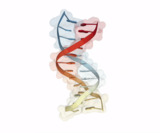
This resource explains the structure and function of DNA using PowerPoint. Videos and practice are linked into the presentation.
- Subject:
- Life Science
- Material Type:
- Lecture
- Author:
- Despina Mitsos
- Date Added:
- 07/13/2023

This resource explains the structure and function of DNA using PowerPoint. Videos and practice are linked into the presentation.
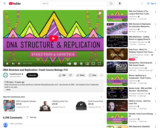
Hank introduces us to that wondrous molecule deoxyribonucleic acid - also known as DNA - and explains how it replicates itself in our cells.
Chapters:
1) Nucleic Acids
2) DNA
-A) Polymers
-B) Three Ingredients
-C) Base Pairs
-D) Base Sequences
3) Pop Quiz
4) RNA
-A) Three Differences from DNA
5) Biolography
6) Replication
-A) Helicase and Unzipping
-B) Leading Strand
-C) DNA Polymerase
-D) RNA Primase
-E) Lagging Strand
-F) Okazaki Fragments
-F) DNA Ligase
Review
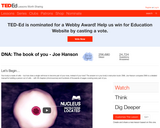
Your body is made of cells -- but how does a single cell know to become part of your nose, instead of your toes? The answer is in your body's instruction book: DNA. Joe Hanson compares DNA to detailed manual for building a person out of cells -- with 46 chapters (chromosomes) and hundreds of thousands of pages covering every part of you.

As a class, students work through an example showing how DNA provides the "recipe" for making our body proteins. They see how the pattern of nucleotide bases (adenine, thymine, guanine, cytosine) forms the double helix ladder shape of DNA, and serves as the code for the steps required to make genes. They also learn some ways that engineers and scientists are applying their understanding of DNA in our world.
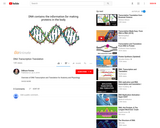
Short video covering DNA transcription/translation for Anatomy and Physiology.

Overview of DNA and chromatin regulation.
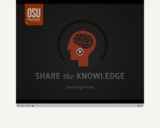
This activity will help students understand how the enzyme telomerase works to solve the "end replication problem."

Introduction to DNA cloning.

How DNA is copied (replication). How information in DNA can be used to make a protein.

This course will explore the current frontiers of the world of RNA biology with primary research papers to trace how the original odd detail sometimes leads to major discoveries. As we discuss the different transcripts and processing events that enable this exciting diversity of RNA functions, we invite you to read landmark papers with us, think critically, and ask new questions, as we marvel at the wonders of RNA.
This course is one of many Advanced Undergraduate Seminars offered by the Biology Department at MIT. These seminars are tailored for students with an interest in using primary research literature to discuss and learn about current biological research in a highly interactive setting. Many instructors of the Advanced Undergraduate Seminars are postdoctoral scientists with a strong interest in teaching.
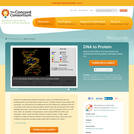
Explore the relationship between the genetic code on the DNA strand and the resulting protein and rudimentary shape it forms. Through models of transcription and translation, you will discover this relationship and the resilience to mutations built into our genetic code. Start by exploring DNA's double helix with an interactive 3D model. Highlight base pairs, look at one or both strands, and turn hydrogen bonds on or off. Next, watch an animation of transcription, which creates RNA from DNA, and translation, which 'reads' the RNA codons to create a protein.
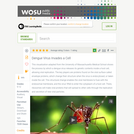
In this visualization adapted from the University of Massachusetts Medical School, discover the role that dengue viral proteins play in a human cell as the virus prepares to replicate.

This presentation talks about which role exercise plays in developing diabetes. We will describe what happens in the body when we exercise, and why these changes help us prevent and treat diabetes. In continuation of this we’ll talk about the interaction between insulin, glucose and muscle cells and how we through exercise, can change our health. Furthermore we’ll discuss how lifestyle can affect one’s future children in terms of developing diabetes later on.
Narrator: Richard Steed.

In this video module, students learn how scientists use genetic information from dogs to find out which gene (out of all 20,000 dog genes) is associated with any specific trait or disease of interest. This method involves comparing hundreds of dogs with the trait to hundreds of dogs not displaying the trait, and examining which position on the dog DNA is correlated with the trait (i.e. has one DNA sequence in dogs with the trait but another DNA sequence in dogs not displaying the trait). Students will also learn something about the history of dog breeds and how this history helps us find genes.
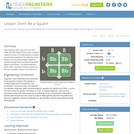
After watching video clips from the Harry Potter and the Goblet of Fire movie, students explore the use of Punnett squares to predict genetic trait inheritance. The objective of this lesson is to articulate concepts related to genetics through direct immersive interaction based on the theme, The Science Behind Harry Potter. Students' interest is piqued by the use of popular culture in the classroom.

DNA contains instructions that are needed for our bodies to survive. DNA is needed for us to develop and reproduce. All body systems depend on DNA to function. In this activity, you will be extracting DNA from a piece of fruit. The purpose of this activity is to give you a first hand look at the long chained molecule of DNA. DNA relates to all of our body systems, and this lab will give you a better understanding of what DNA is.
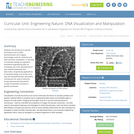
Students are introduced to genetic techniques such as DNA electrophoresis and imaging technologies used for molecular and DNA structure visualization. In the field of molecular biology and genetics, biomedical engineering plays an increasing role in the development of new medical treatments and discoveries. Engineering applications of nanotechnology such as lab-on-a-chip and deoxyribonucleic acid (DNA) microarrays are used to study the human genome and decode the complex interactions involved in genetic processes.
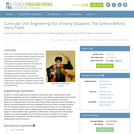
Under the "The Science Behind Harry Potter" theme, a succession of diverse complex scientific topics are presented to students through direct immersive interaction. Student interest is piqued by the incorporation of popular culture into the classroom via a series of interactive, hands-on Harry Potter/movie-themed lessons and activities. They learn about the basics of acid/base chemistry (invisible ink), genetics and trait prediction (parseltongue trait in families), and force and projectile motion (motion of the thrown remembrall). In each lesson and activity, students are also made aware of the engineering connections to these fields of scientific study.

This resource is a video abstract of a research paper created by Research Square on behalf of its authors. It provides a synopsis that's easy to understand, and can be used to introduce the topics it covers to students, researchers, and the general public. The video's transcript is also provided in full, with a portion provided below for preview:
"The characteristics of the world around us vary from one location to the next. This is also true of aquatic environments, where bottom-dwelling microorganisms must cope with variation in temperature, salinity, dissolved oxygen, and nutrients. Unfortunately, little is known about how these microbial communities and their functional genes respond to environmental changes. A team of researchers at Stockholm University recently set out to do just that by collecting samples of sediment at 59 sites spanning 1,145 km across the Baltic Sea. They characterized the environmental attributes and microbial community at each site using genetic sequencing and other laboratory techniques. The researchers found that salinity and dissolved oxygen content had the greatest effects on the microbes making up each community with the communities in oxygen-deficient “dead” zones being particularly dissimilar to those with higher dissolved oxygen content..."
The rest of the transcript, along with a link to the research itself, is available on the resource itself.

¿Podemos ver el ADN de un plátano a simple vista?En este experimento vamos a comprobar cómo mediante los procedimientos sugeridos podemos llegar a visualizar la cadena de ADN de un plátano. Para ello, sólo tenemos que seguir los pasos que se plantean a continuación.